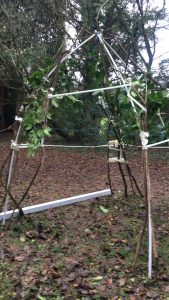- Group and leadership
- Was there a group leader?
- – We did not assign a group leader, however, Owen, in particular stood out as the group leader
- If informal, how did you know? What were the actions that marked them as a leader? – Owen came up with the idea of a teepee, as it would be free standing so it was more original than building dens into the trees. He has also had experience of den building from helping out at beavers, so was familiar with tying the sticks together and how to make it as sturdy as possible.
- How did this impact on the rest of the group e.g. was there some underlying resentment/ did anyone feel excluded? – Nobody felt excluded, as we all had our own ideas and we were able to make all of these work towards our final product.
- What was most challenging for you about working in this group? (personal reflection) – the most challenging part was that I did not know everyone in my group well, but we all got on great and worked together very well.
- Explaining
- How clearly did you think the group explained to you? – The other group explained their den very well.
- What made this clear or unclear? – They made it clear by explaining HOW they made their den and WHY they made their den this way
- What stage of the 5Ps might have been missed out?
- Environment
- What was the impact of the environment on your communication? – I felt the environment was much more laid back and relaxed. I felt at ease, less tense and I felt as if my teammates did too. This meant there was a highly positive atmosphere and we all communicated with enthusiasm,
- What changes did you make when explaining to others that you might not have considered in a typical classroom? – We used humour and pretended that our den was luxurious and available for hire! haha. This just shows how relaxed the atmosphere was compared to the classroom. We also stood randomly and in a circle kind of shape which would not usually happen in a classroom but it made it easier to discuss.
- How challenging was it so speak above the sounds in the environment? – Very easy as it was easily forgotten about after a while. How can we make this communication easier on both speaker and listener?
- When listening, did the environment distract you? How can we overcome this? – No, the environment was never a distraction
- Negotiation
- Were your negotiations successful? Why/Why not? – Yes, our negotiations were all successful as we managed to use all ideas, such as what sticks to use, leaves and how we tied it together.
- What was most challenging about these? What was most challenging was deciding where the location of the den should be as we had a few different options. But we chose in the open as we thought it required a bit more initiative.
DEN BUILDING! :)
Group and leadership Was there a group leader? – We did not assign a group leader, however, Owen, in particular stood out as the group leader If informal, how did you know? What were the actions that marked them as a leader? – Owen came up with the idea of a teepee, as it would … Continue reading “DEN BUILDING! :)”


